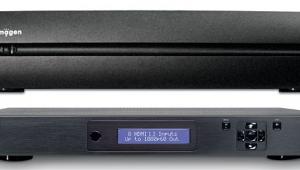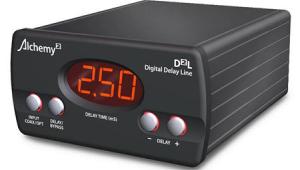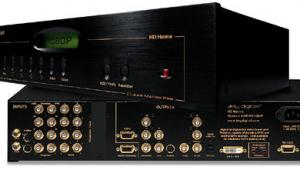This looks fantastic, but that's far too few inputs.
DVDO Quick6 HDMI Switcher

AT A GLANCE
Plus
Full 3D and UHD support
Blazing fast switching
Options for legacy device support
Minus
USB location may be tricky for some
THE VERDICT
DVDO redefines what to expect from an HDMI switcher and lets your older gear play nice with the new stuff.
When I think of a video switcher, my mind’s eye typically sees a boring little box (with some buttons on the front) that does nothing more than link one of its inputs to a common output. DVDO’s Quick6 is entirely different. Not only is it the fastest HDMI switching device I’ve ever come across, but it also has a ton of useful features that can help both new and old systems alike with today’s cutting-edge gear.
More Than Just a Switch
From the outside, the Quick6 looks like a common HDMI switching device. The front panel is a straightforward design with LED indicators for the sources and a button to select the active input. But the back panel immediately clues you in that there’s more going on here than just basic HDMI switching. The Quick6 has (surprise!) six HDMI inputs, two of which are MHL compatible for connecting portable devices (such as phones or tablets) and enabling power for some sources. There are also two HDMI outputs.
Although the Quick6 was certified upon its launch for HDMI 1.4a (the highest HDMI certification at the time), DVDO says it has a 300 megahertz HDMI receiver and is compliant with the new HDMI 2.0 standard, passing both 3D and 4K signals up to 60 frames per second. If you upgrade to a 4K or Ultra HD display, it can even keep you from having to replace your old AVR or prepro with a new HDMI 2.0 model. Plug your 4K sources into the Quick6, and it will feed 4K video from each input to the display while stripping off the sound from the signal, then superimposing it on a 720p bluescreen that your AVR will recognize before sending it along via HDMI for normal audio playback.
There are also two digital outputs, one TosLink, and one digital coaxial, for systems that don’t have the ability to do any HDMI audio. So if you have an old display or A/V receiver—or even a soundbar—that takes only a standard digital audio input, the Quick6 has you covered. In much the same way, it can redirect any incoming HDMI audio signal directly to the digital outputs. If that signal is either Dolby TrueHD or DTS-HD Master Audio, the Quick6 ’s TosLink and coaxial digital audio outputs simply pass the core, lossy Dolby Digital or DTS bitstream and send it along to the connected component. (Only HDMI can carry either lossless Dolby TrueHD or DTS-HD Master Audio digital bitstreams; TosLink and coaxial digital connections cannot.) This was immensely helpful in my family-room setup using the new Sonos Playbar, which has only a single optical audio input.

The back panel also features an RS-232 input for control systems and a USB input for firmware updates. I was a bit annoyed with the USB port being on the back. Depending on your rack, it can be difficult to access the back panel to plug in a USB drive for updates. I ended up using a USB extension cord to alleviate the issue in my personal setup.
The Quick6 comes with a small remote control that offers direct access to any input and to the setup menus and some other neat features. Because the Quick6 uses the latest HDMI tools from DVDO’s parent company, Silicon Image, it has some features you don’t typically see in HDMI devices. One is InstaPrevue. Since the Quick6 keeps all its HDMI connections live even when they’ve not been selected, you can bring up a preview of all the powered-up HDMI sources that are feeding the unit. This allows you to switch directly to whatever you see running without the typical time delays or blackouts attendant to HDMI connections (more on this later). You can even select where the preview screens show up on the display! And there is also a PIP function, which is useful when you want to bounce between games or shows.
Setting Up
Setup was easy, and the downloadable user manual is pretty clear on the options available. The onscreen menus are simple to navigate and give you a lot of flexibility.
There are two AVR modes to choose from. These let you have one HDMI output feeding a display while the other feeds an AVR or a surround processor. This is helpful for those who have older AVRs or processors that wouldn’t be able to switch HDMI sources that include 3D playback or (as noted) even 4K video. If you’re using the HDMI output to feed your AVR, the Quick6 polls the AVR to make sure it sends the highest audio quality it’s capable of, including Dolby TrueHD and DTS-HD Master Audio. If it’s an older AVR with HDMI inputs that don’t support those formats, the Quick6 sends only the core Dolby Digital or DTS bitstream. If your AVR doesn’t have HDMI inputs, you can send audio via the Quick6 ’s TosLink or digital coaxial outputs, as I mentioned before.
When in HDMI mode, the Quick6 will mute any audio going to the TV as long as your AVR or surround processor is on. If you have it turned off, the Quick6 will pass along the audio to your TV so you can enjoy your sound from there—very practical for those who may not always want to use their full sound system for audio playback.
Another setup option is Mirror Mode, which basically sends an identical signal from both HDMI outputs. This would apply to a two-display system, so you could watch the same thing on two different screens (or on both a standard TV and a video projection system). It even supports Audio Return Channel (ARC) for those who have their AVR or surround processor connected via one of the digital outputs.
- Log in or register to post comments


The DVDO Quick6 HDMI switcher is a feature-rich solution that offers blazing-fast switching, full 4K/60fps and 3D support, and excellent compatibility with both modern and legacy AV gear. With six HDMI inputs (including MHL support), dual outputs, and digital audio options (TosLink and coaxial), it easily integrates into any setup—making it especially useful for content creators using tools like CapCut Pro APK who need smooth, lag-free signal routing and multi-screen previewing. Features like InstaPrevue, PIP, and AVR modes enhance usability, though the rear USB port for updates can be inconvenient. Overall, the Quick6 redefines what an HDMI switcher can do, blending advanced tech with practical versatility.





















































